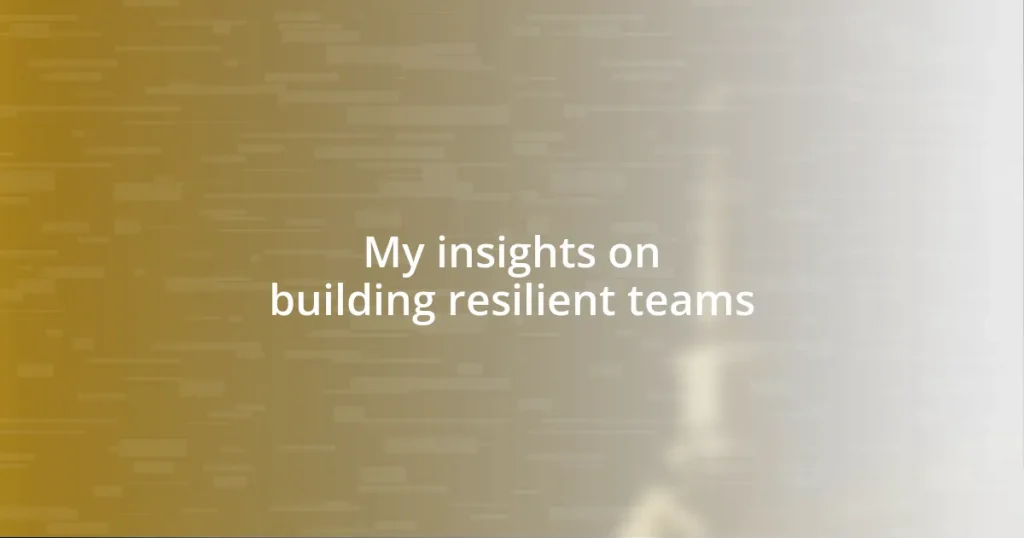Key takeaways:
- Resilient teams thrive on adaptability, strong trust, open communication, and a positive mindset, transforming challenges into opportunities for growth.
- Building trust involves creating a safe space for vulnerability and consistently delivering on commitments, which enhances team dynamics.
- Implementing strategies like regular check-ins, recognizing contributions, and team-building activities fosters resilience and strengthens interpersonal connections.
- Measuring resilience through surveys and observing behaviors in high-pressure situations provides valuable insights for continuous improvement.
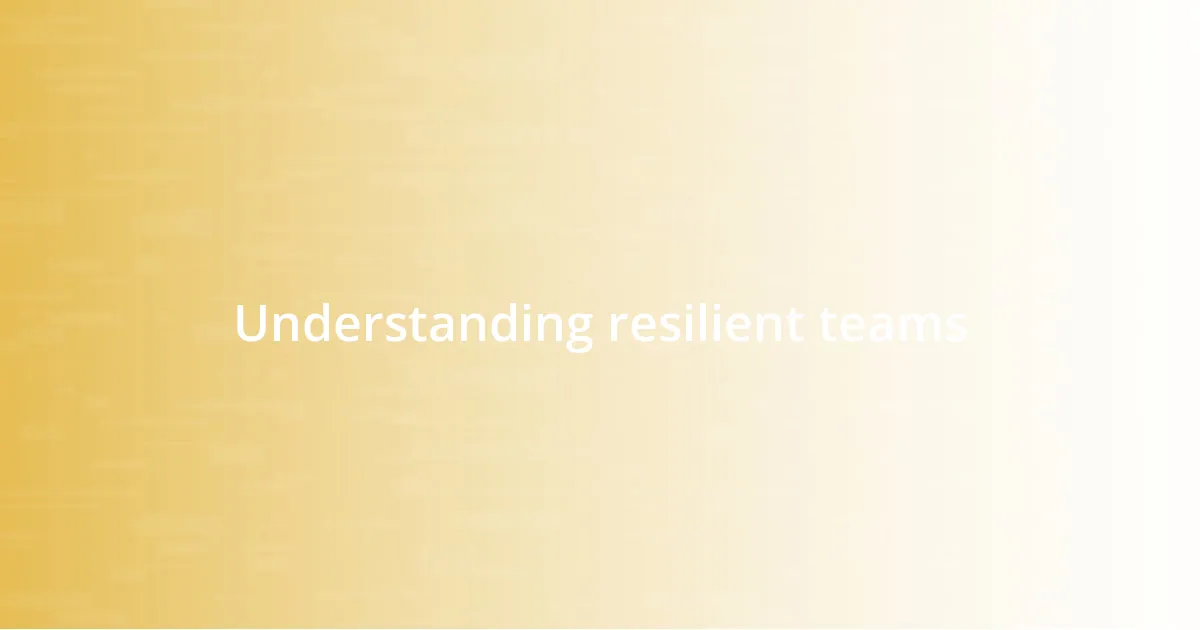
Understanding resilient teams
Understanding resilient teams involves recognizing their ability to adapt and thrive in the face of challenges. In my experience, I’ve seen teams that embrace change and view failures as learning opportunities transform setbacks into stepping stones. Isn’t it fascinating how a shift in perspective can lead to breakthroughs?
One of the most striking qualities of resilient teams is their strong interpersonal connections. I recall a time when my team faced an unexpected project deadline. Instead of crumbling under pressure, we rallied together, sharing our strengths and vulnerabilities. That bond not only helped us meet the deadline but also deepened our trust in one another—an invaluable asset that persists even today.
At the heart of resilience lies a culture of open communication and support. Reflecting on my journey, I’ve often wondered: how can we create environments where everyone feels safe to express their ideas and doubts? By actively listening and encouraging feedback, teams can create a space where innovation flourishes and challenges are met with confidence. Isn’t that the kind of team you’d want to be a part of?
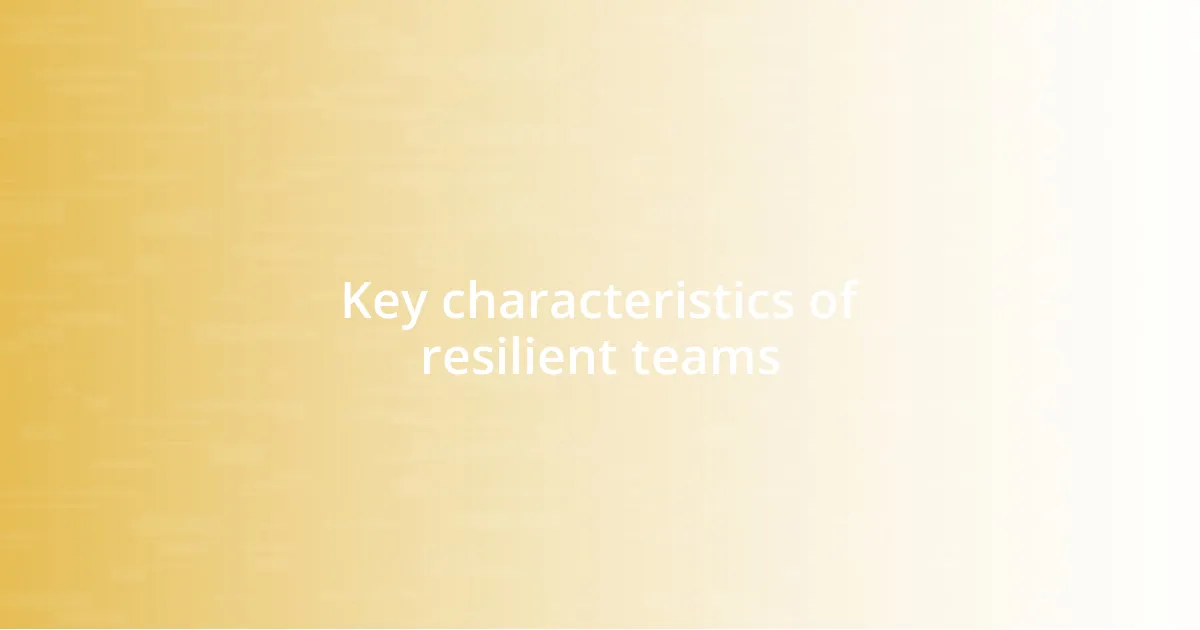
Key characteristics of resilient teams
Resilient teams share a cluster of characteristics that enable them to navigate adversity effectively. For me, one key trait is adaptability; I remember when my own team was pushed to pivot during a project’s mid-phase due to unexpected market changes. Instead of resisting, we embraced the shift, which not only kept us on track but also sparked innovative solutions we hadn’t considered before. This ability to adjust and thrive amid uncertainty is crucial for robust teamwork.
Here are some vital characteristics that define resilient teams:
- Strong Trust: Team members are comfortable being vulnerable and expressing concerns.
- Mutual Support: Colleagues actively help each other, fostering an environment of cooperation.
- Flexibility: The team can quickly adapt to new circumstances and alter plans as needed.
- Open Communication: Honest discussions about challenges and possibilities are encouraged.
- Positive Mindset: Members maintain an optimistic outlook, focusing on solutions instead of problems.
In my observation, these dimensions intertwine seamlessly, creating a canvas where resilience can flourish. It’s reminiscent of when we faced a major setback and chose to focus on what we could still accomplish, transforming challenges into opportunities for growth.
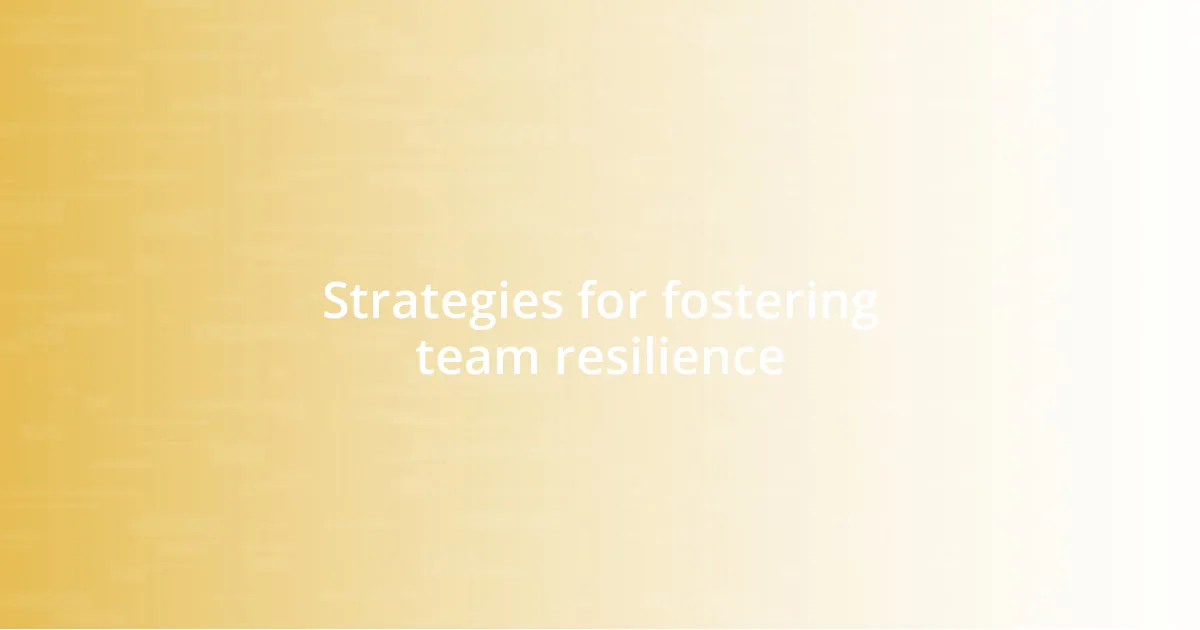
Strategies for fostering team resilience
Building resilient teams is all about implementing practical strategies that foster adaptability and strong connections among team members. One effective approach I’ve found is establishing regular check-ins. These meetings not only keep everyone aligned, but they also provide a platform to discuss feelings and share ideas. I remember a time when my team felt overwhelmed by our workload; after introducing these check-ins, we discovered that simply voicing our challenges together made a world of difference.
Additionally, encouraging a culture of recognition plays a significant role in resilience. When team members acknowledge each other’s contributions, it cultivates a sense of belonging and trust. There was a project I worked on where, during a particularly intense phase, we made it a point to celebrate small wins. This practice not only lifted our spirits but also reinforced our commitment to one another, reminding us that we were in it together.
Lastly, investing in team-building activities can bond members beyond work-related interactions. These moments allow us to relate to each other on a personal level, which ultimately strengthens collaboration. I recall a retreat we had where we participated in a cooking class together. The laughter and teamwork required to whip up a meal helped us forge deeper connections that paid off during high-pressure projects.
| Strategy | Description |
|---|---|
| Regular Check-Ins | Scheduled meetings to discuss workloads, feelings, and ideas. |
| Culture of Recognition | Acknowledging each other’s contributions to boost morale and trust. |
| Team-Building Activities | Engaging in non-work-related activities to strengthen personal bonds. |
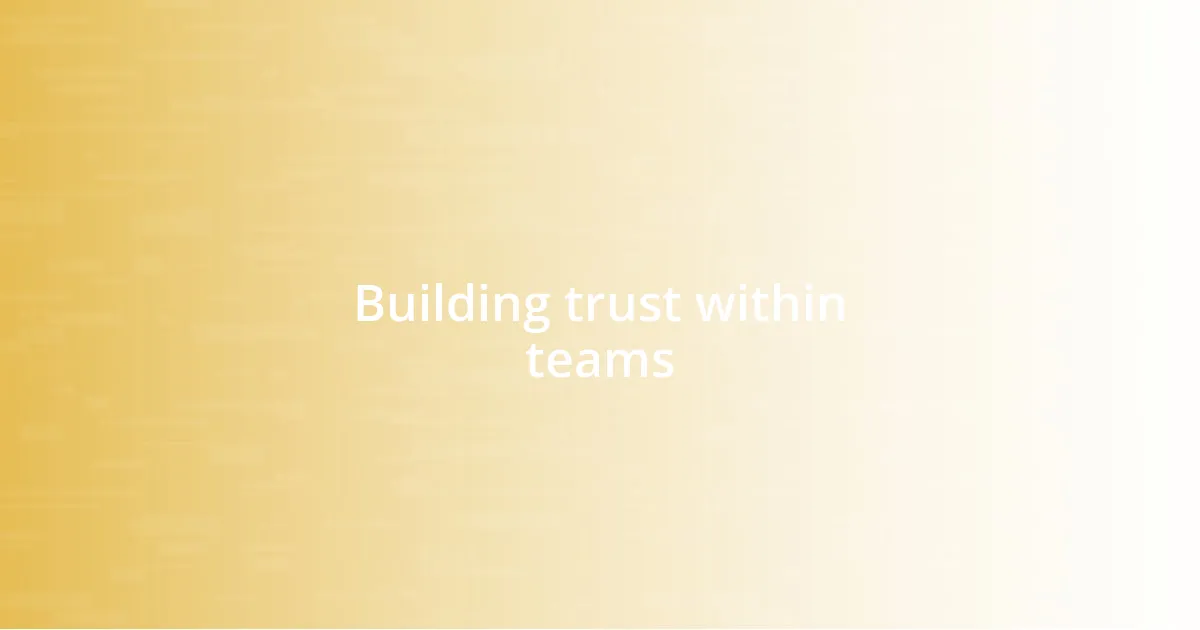
Building trust within teams
Trust is the foundation of any effective team. I remember a time when I took a leap and shared a personal challenge during a meeting. The response was overwhelming; my colleagues opened up about their own struggles. This moment transformed our dynamics, making vulnerability a shared strength rather than a risk. Have you ever witnessed such openness in your team? It can be incredibly liberating.
Creating a safe space for sharing fosters trust, but it takes consistent effort. I’ve learned that intentional team-building exercises—like sharing “wins” or challenges at the end of each meeting—help build this environment. I once facilitated a session where team members discussed not just project updates but also personal achievements. The warmth and laughter that ensued were not just uplifting; they deepened our connections and reinforced that we genuinely care for one another.
Another crucial aspect of trust is delivering on commitments. When team members follow through on their promises, it reinforces reliability. I’ve seen firsthand how a small act—like a teammate promptly addressing a task or supporting another with a deadline—can solidify confidence and assurance. Trust thrives on these daily interactions, and acknowledging them can truly bolster a team’s resilience during tough times. How does your team celebrate these moments of support?
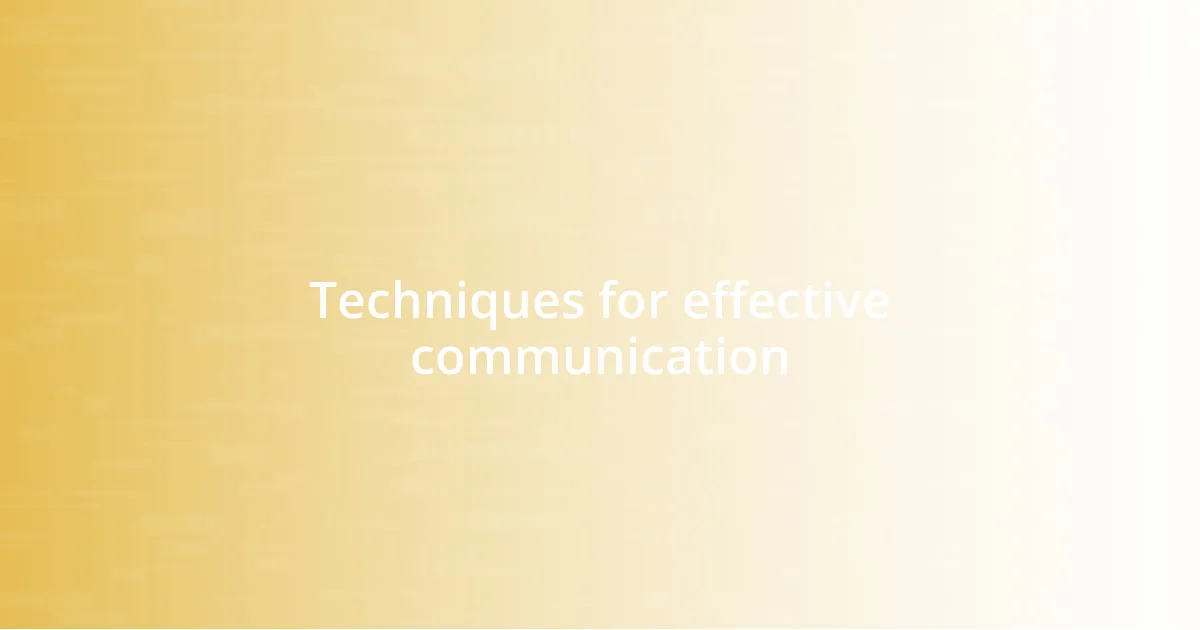
Techniques for effective communication
Effective communication is essential for nurturing resilience within a team. One technique I’ve found immensely beneficial is the practice of active listening. In my experience, when team members genuinely listen—really listen—to one another, it fosters deeper understanding and collaboration. I recall a time when I was leading a project, and after implementing active listening sessions, the dialogue shifted dramatically. Rather than just hearing replies, we began to understand each other’s perspectives, which minimized conflicts and enhanced our collective creativity. Have you ever found that true listening can open doors to unexpected solutions?
Another powerful approach I often utilize is clarity in messaging. It’s astonishing how often miscommunication stems from assumptions or unclear instructions. I remember a project where, right at the start, we faced confusion due to vague goals. Once we established clear objectives and shared guidelines, everything clicked into place. I’m sure you’ve seen the frustration that arises from misunderstandings, right? Setting explicit expectations not only eases tensions but also empowers team members to take ownership of their responsibilities.
Finally, employing feedback as a communication tool can be transformative. Instead of viewing it solely as criticism, I advocate for a culture where constructive feedback is seen as growth. I once encouraged my team to hold “feedback huddles” after project milestones. This not only created a space for evaluation but also cultivated a mindset of continuous improvement. The emotional uplift of knowing that we’re all striving to be better can significantly strengthen team bonds. How does feedback play a role in your team’s dynamic?
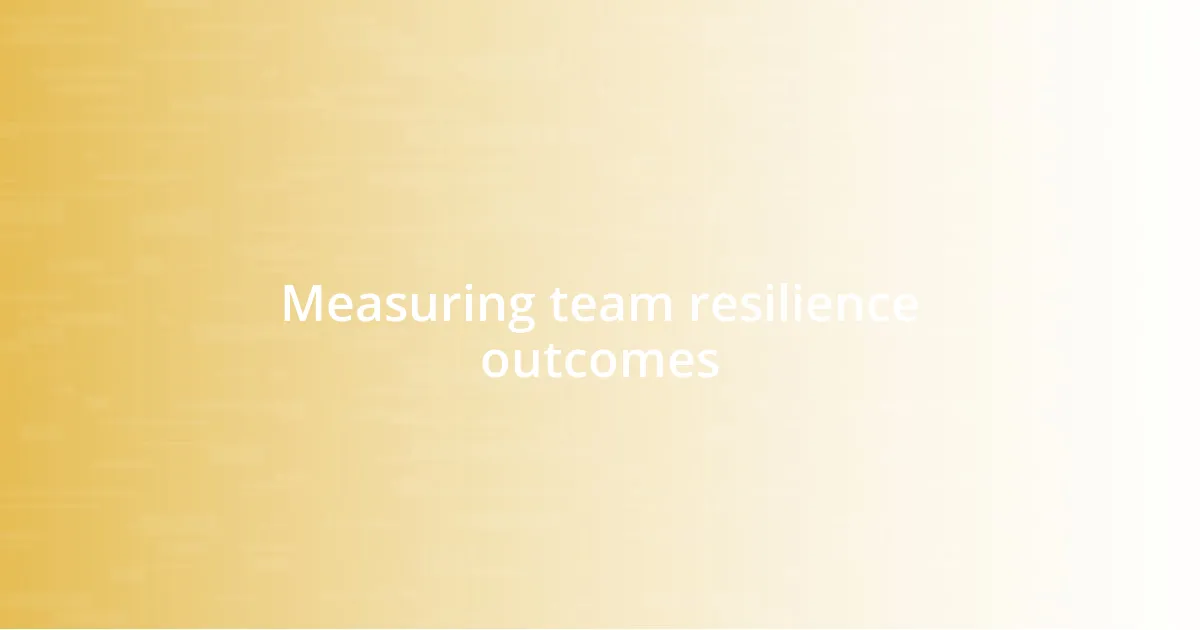
Measuring team resilience outcomes
Measuring team resilience outcomes can sometimes feel elusive, but I’ve found that clear metrics can provide real insight. I recall an initiative where we assessed team resilience through surveys focused on adaptability, trust, and collaboration. The results revealed not just strengths but also areas ripe for improvement, sparking meaningful conversations about how we support each other. Have you ever used surveys to gauge your team’s dynamics?
Another valuable approach is observing behaviors during high-pressure situations. I remember a critical deadline when our team faced unexpected challenges. Watching how individuals reacted—some stepping up to support others while others struggled with stress—highlighted important resilience traits. These moments can serve as real-time assessments, showcasing group dynamics and individual contributions. It makes me wonder: what has your team’s behavior revealed during tough times?
Lastly, I advocate for regular reflections on both successes and setbacks. After completing a major project, I initiated a session for us to analyze what went well and what didn’t. Not only did this foster accountability, but it also created a safe space for vulnerability where team members could share their feelings about the process. The emotional richness of those discussions deepened our resilience, making me realize how vital such reflections are. What practices does your team have in place for reflecting on resilience?










